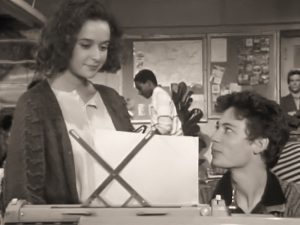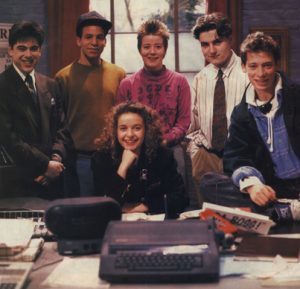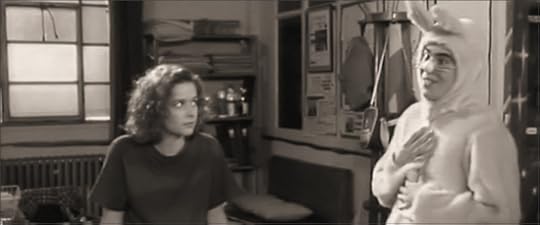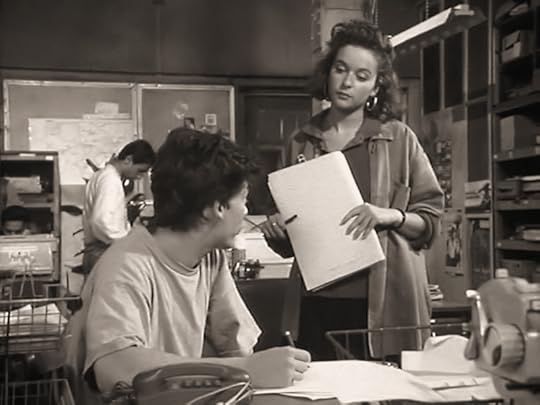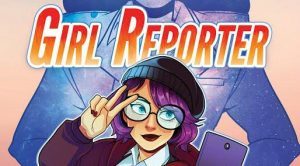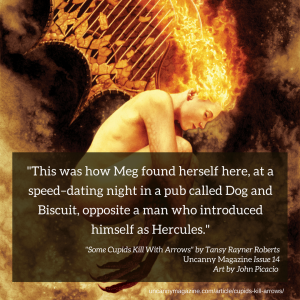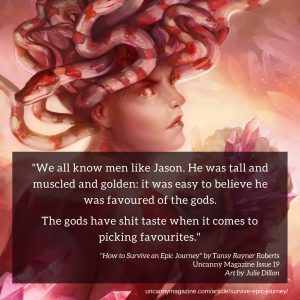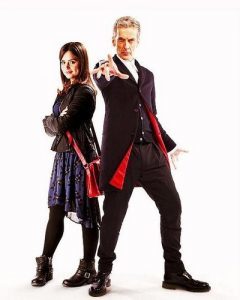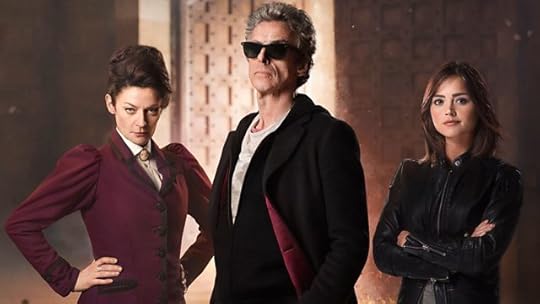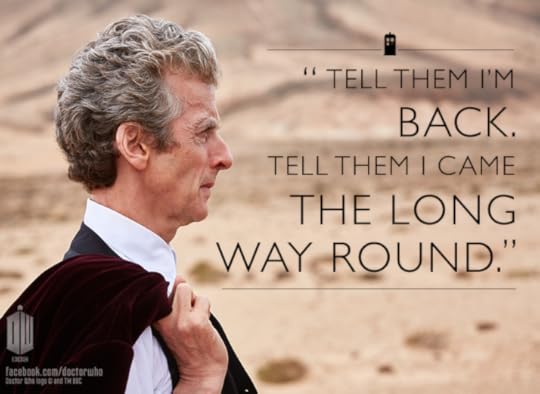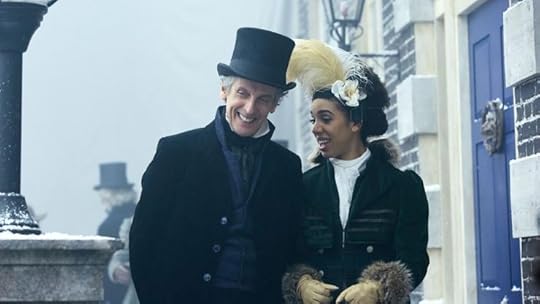Tansy Rayner Roberts's Blog, page 8
January 12, 2018
Girl Reporter: the story so far.
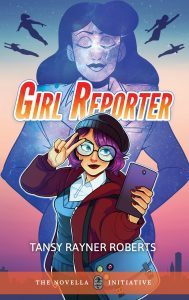 So Girl Reporter was released on 19 December, which is not traditionally a great time to have a book released, but I was delighted with how many people bought it, read it and talked about it in that week.
So Girl Reporter was released on 19 December, which is not traditionally a great time to have a book released, but I was delighted with how many people bought it, read it and talked about it in that week.
If you haven’t heard about Girl Reporter yet, it’s this:
From the award-winning author of Cookie Cutter Superhero and Kid Dark Against the Machine comes a brand new novella about girl reporters, superheroes, and interdimensional travel
In a world of superheroes, supervillains, and a machine that can create them all, millennial vlogger and girl reporter Friday Valentina has no shortage of material to cover. Every lottery cycle, a new superhero is created and quite literally steps into the shoes of the hero before them–displacing the previous hero. While Fry may not be super-powered herself, she understands the power of legacy: her mother is none other than the infamous reporter Tina Valentina, renowned worldwide for her legendary interviews with the True Blue Aussie Beaut Superheroes and her tendency to go to extraordinary lengths to get her story.
This time, Tina Valentina has ventured too far.
Alongside Australia’s greatest superheroes–including the powerful Astra, dazzling Solar, and The Dark in his full brooding glory–Friday will go to another dimension in the hopes of finding her mother, saving the day, and getting the story of a lifetime out of the adventure. (And possibly a new girlfriend, too.)
Like the two stories that preceded it (you can read Cookie Cutter Superhero in celebrated YA anthology Kaleidoscope, and you can get Kid Dark Against the Machine directly from The Book Smugglers) this story is fed by my whole history of loving and being enraged by superhero comics.
It’s a story about friendship, epic LGBTQ romances new & old, superhero legacy and extradimensional space travel in cute retro outfits. There are robot pals. There are teen boffins. There are jokes about Millennials and Australian politics and sexism. It’s the full package.
Girl Reporter also a mother-daughter story, which I’ve never really written before, and am even more self conscious about doing now because my own kids are old enough (or nearly old enough) to read it for themselves… luckily I am nothing like Tina Valentina and not much like Friday Valentina either!
I’m still so in love with this book and I hope it finds its audience.
Here’s some blogging/cool stuff I’ve been working on over the last month to promote Girl Reporter:
My recent essays about girl reporters:
Inspirations & Influences: Girl Reporter, a summary of how I got from there to here, with a great deal of discussion of Lois Lane. Because Lois Lane.
Five Things I Learned While Writing Girl Reporter, an honest piece about writing flaws and things I’m still learning about myself, at Chuck Wendig’s Terrible Minds blog.
LGBTQ comics & superhero media recs by me, at LGBTQ Reads.
Narrelle M Harris asks me Questions about Girl Reporter.
There’s Nothing Only About Being A Journalist: An Appreciation of Sarah Jane Smith, a sweeping, slightly epic summary of one of the most important characters in the history of Doctor Who, and whether or not she was good at her job.
His Girl Hildy, a review of 1940 romantic comedy classic about an editor, a reporter, and the newspaper they love.
Da Boss: Lynda Day & her Boy Reporter, a review of a hugely influential kids TV show about an editor, the newspaper she loves, and the reporter who loves her.
The Truth Has Got Her Boots On (Revised), from my Pratchett’s Women series of feminist Discworld essays, about a reporter and an editor inventing the newspaper business from scratch, and probably falling in love… with their newspaper.
Not remotely related to Girl Reporter but totes superhero-y, a recent Storify of my livetweeting of original Thor. I can’t believe Storify is quitting on us!
January 11, 2018
Let Sleeping Princes Lie Part 12
Let Sleeping Princes Lie – Part 12, Ablutions.
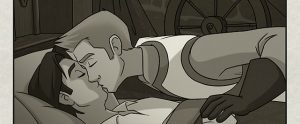
Previous Episodes of this story:
Part 1, Charming Dreaming
Part 2, The First Rule of Spinning Wheels
Part 3, Royal Coping Mechanisms 101
Part 4, You Spin Me Right Round, Baby
Part 5, Kiss the Quill
Part 6, Somewhere Over the Rainbow
Part 7, Sometimes, Witches
Part 8, Monsters Under the Bed
Part 9, Gone To See A Witch About A Spinning Wheel
Part 10, Snakes in a Tower
Part 11, Read All About It
New book alert! My superhero novella Girl Reporter is available to buy now, as ebook and paperback.
Sign up to my author newsletter for updates, follow me on Twitter at @tansyrr or @sheepmightfly, find me on Facebook at TansyRRBooks, and if you like this podcast consider supporting me at Patreon where you can receive all kinds of cool rewards, early ebooks and exclusive stories for a small monthly pledge.
See you next week!
The Truth Has Got Her Boots On (revised)
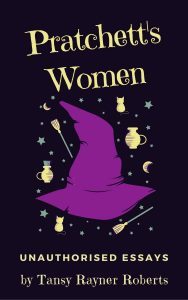 So this week I put up a revised edition of my Pratchett’s Women collection on Amazon, both Kindle & paperback. And it occurred to me as I was working through the essays that this particular one made a nice crossover with all the other “women & newspapers” themed essays I’ve been putting up to promote my new novella, Girl Reporter.
So this week I put up a revised edition of my Pratchett’s Women collection on Amazon, both Kindle & paperback. And it occurred to me as I was working through the essays that this particular one made a nice crossover with all the other “women & newspapers” themed essays I’ve been putting up to promote my new novella, Girl Reporter.
So here it is! Women who love men who love newspapers! (Who would have thought there were so many pop culture examples of threesome romances between two people and their newspaper?)
The Truth (2000)
I almost wasn’t going to write a Pratchett’s Women piece for The Truth. Like Night Watch, it’s a marvellous book, but I never thought of it as one that had much to say about women or gender. The Truth is a love letter to moveable type, and a fun take on the history of the printing press, with the usual Discworld layers of humour and cleverness, and a rich cast of characters. It’s easily forgiven it for the ensemble being so overwhelmingly male. This was the book that brought me back to the Discworld after losing interest somewhere in its middle years.
I wasn’t alone in that. The Truth was a huge success for Terry Pratchett, and is one of the books that helped to cement his ‘legend’ status among mainstream readers as well as diehard fans. He had previously written other novels with a similar formula (standalone male character deals with the Discworld’s crazy version of an industrial development borrowed from our own history, and chaos ensues) but there was something about this book, and its maturity, that made it special. This is also a story that features fewer overt fantasy elements than any previous Discworld novel—it’s certainly not a story about magic gone wrong and trying to kill you, which sets it apart from the series. Instead, this is a story of PEOPLE gone wrong and trying to kill you, and how societal change can be every bit as terrifying and dangerous as anything from the Dungeon Dimensions.
Did I mention? This novel is magnificent.
On my reread I discovered that the story of William de Worde and The Ankh-Morpork Times is very much a story about gender issues, though William himself is unaware of it. The Truth is about the patriarchy, and how it hurts men every bit as much it hurts women. If I was writing a book about Pratchett’s Men (and really, someone should, I would read the hell out of that book) I would discuss how traditional masculinity and other paternal themes are continually addressed and undercut in this story, which is very much about the Men Who Shape The World and the Legacy They Leave Behind. This continues the Discworld tradition of subverting narratives of masculinity—he’s been doing this from page 1, book 1, with characters like Rincewind and Twoflower, Vetinari, Ridcully, Vimes, Moist Von Lipwig, Cohen the Barbarian and even some of the one-off ‘heroes’ like Pteppic, Buddy and Victor.
But this is not that book. So I’m going to talk about Sacharissa Cripslock.
Sacharissa is the only full-blooded female character in a sea of mostly invisible women (including the upwardly mobile wife and daughter of Harry King, William’s sister, the dwarves who might not be male after all, a few absent mothers and so on). Mrs Arcanum the landlady and her Opinions represent an important ongoing subplot, though rather more attention in those scenes is given to Mr Windling and his Opinions—Mrs Arcanum is saved mostly for comic relief. Sgt Angua makes an important cameo appearance, though she looms larger in the books behind the scenes than actually on the page. There is a running joke based on William’s belief that Nobby Nobbs is the rumoured werewolf in the City Watch, and the reader’s presumed knowledge that in fact it is Angua. Sadly, as in the City Watch books, most of the interesting things Angua gets to do happen offpage.
But Sacharissa is pretty awesome. Apart from the running gag about her boobs (they are mighty and marvellous to behold, by all accounts) and the oft-quoted line about her face being ‘eclectically attractive’, she is very much part of the story because of her personality. Pratchett is at his most comfortable when writing intensely pragmatic women, and Sacharissa is very much in this vein. Her primary personality quirk at the beginning of the story is an obsession with historically ladylike behaviour, and what is ‘seemly’ for a lady to do, wear and say (which pretty much puts her on par with Mrs Arcanum). While William thinks such beliefs are frivolous and unnecessary, for Sacharissa they must be essential survival skills in a world that veers from medieval attitudes to Victoriana to modern and back again without even a moment’s notice. After all, she lives in a city that still thinks calling prostitutes ‘seamstresses’ is highly amusing.
I highly enjoyed watching Sacharissa steal the novel from under William’s feet. Their romance, if you can call it that, is one of those vague baffled courtships that Pratchett writes so well, in which both parties spend the whole time loudly thinking about everything except their attraction to each other, and dancing around the subject so subtly that you’re not always sure that he meant you think it was a romance at all. But for the most part, Sacharissa isn’t bothered about impressing William—instead, they both fall deeply and equally in love with the newspaper business.
This romance is a threeway.
While most scenes are written from William’s point of view, and Sacharissa is largely presented to the reader through his eyes, we still see how her love affair with The Ankh-Morpork Times unfolds differently to his. She’s the one who embraces many of the practical day-to-day details of the business, like why you report on meetings with lots of names in them, how to cover the ordinary parts of city life, and especially how to craft headlines. While William is figuring out from the ground up how to manage concepts like Freedom of the Press, and how to report on big, ‘weighty’ political issues, Sacharissa is working behind the scenes to figure out everything else you need to put in a newspaper so that it is more than a front page. He’d be lost without her, and it’s nice that by the end he has acknowledged that fact.
She’s not doing the grunt work for no recognition, either. While William struggles against some of the realities of the printing and news trade, Sacharissa is several steps ahead of him. Her competence is shown clearly, and while William resents Sacharissa using her attractiveness to gain news tidbits from eager young men, there is more to her methods. She starts out with the contacts and experience in the printing industry that William lacks—in fact she only joins the Times in the first place after coming over to complain about her father the printer being put out of business.
Now that I come to think of it I’m not entirely convinced that the novel needed William in it.
Sacharissa’s character arc in The Truth comes to a climax with the resolution of another running gag, that of the hardboiled thug Mr Tulip and his method of swearing (mostly saying ‘-ing’ a lot without bothering to fill in the verb). William sends Sacharissa into a socially awkward situation, giving her the key to his family’s townhouse and permission to raid his sister’s wardrobe for a suitable dress to wear for a ball. This goes against Sacharissa’s instincts about feminine respectability, and she is so busy trying to deal with the fact that she’s burgling a house (it never occurred to him to go with her to make her ‘borrowing’ legitimate) that she ends up in a far more dangerous situation, taken hostage by two assassins.
It’s here that the Lois Lane analogy, which has been strongly implied in her Girl Reporter role so far, looms larger. Being kidnapped by bad guys was an everyday occurrence for the sassy reporter of the Daily Planet, but Sacharissa doesn’t have a pet superhero to rescue her—and so she throws caution and her last vestiges of ‘respectability’ to the wind in order to rescue herself, along with a healthy bout of yelling and swearing, which she finds rather cathartic.
After that, it’s up to Sacharissa and William to save their mutual true love, the newspaper itself, from disaster…
I find Sacharissa a likeable, complicated and useful character in an excellent novel. But I’m not entirely sure what her character is supposed to represent. Is she a satire on a certain old fashioned kind of young lady who needs to loosen her corsets a bit? Is her character journey about worrying less about what people think of her? Is she a feminist character, or an example of why the women of the Discworld need organised feminism? Mostly I think she’s far too busy doing her goddamned job to worry about such things.
When she turns up again in Going Postal, it is noted that she wears a wedding ring, but continues to call herself ‘Miss Cripslock’. So there’s one piece of evidence that she is embracing modernism.
If nothing else, Sacharissa is a great example of a practical woman in a fantasy novel who dresses sensibly and is excellent at her job. Which now I come to think about it, makes her a spectacularly important role model. While there hasn’t yet been a movie or other media adaptation made of The Truth (which is a shame because it would be brilliant), Sacharissa’s passing role in Going Postal means that she has been portrayed on the small screen by the comic actress Tamsin Greig. This makes her about 20 years older than she is portrayed in the books, but considering how briefly she appears that’s hardly important. The essence of the character as a caller-of-bullshit in modest attire is definitely there.
Amazingly, on the original book cover, Josh Kirby managed to draw Sacharissa with at least as many clothes on as she is described as wearing in the book. I consider that a triumph of sorts, compared to his earlier work.
 Pratchett’s Women is a collection of ten essays by Tansy Rayner Roberts, looking at the portrayal of female characters in many of Pratchett’s best loved books, from the early years of fantasy satire and sexy lamps to the more complex, iconic characters of the witches, werewolves, dwarves and queens.
Pratchett’s Women is a collection of ten essays by Tansy Rayner Roberts, looking at the portrayal of female characters in many of Pratchett’s best loved books, from the early years of fantasy satire and sexy lamps to the more complex, iconic characters of the witches, werewolves, dwarves and queens.
Contains 10 essays about gender and the Discworld, including “Socks, Lies & the Monstrous Regiment” which is exclusive to this collection.
My recent essays about girl reporters:
Five Things I Learned While Writing Girl Reporter
There’s Nothing Only About Being A Journalist: An Appreciation of Sarah Jane Smith
Inspirations & Influences: Girl Reporter
January 7, 2018
Da Boss: Lynda Day and her Boy Reporter
Another essay on inspirations for my novella Girl Reporter. This one is about Press Gang, an essential TV show from my childhood, about teenagers running a newspaper.
KENNY: 8:30, I was trying to tell you.
LYNDA: Have we done three hours already? (Stands up for announcement) All right everyone, pack up and get out. It’s 8:30. Time for school.
I recently risked the wrath of the suck fairy by starting a rewatch of Press Gang along with my kids. I adored this show as a teenager. I imprinted on it like a baby duckling. I loved the banter, the friendship, the snark, the romance, and most of all, the work ethic.
Press Gang (1989-1993) written by then-newcomer Steven Moffat, is a show about teenagers given the chance to be treated like adults: to run their own newspaper, with the distant support and safety net of adult mentors. I was a thirteen year old writing novels in my bedroom: like Lynda and Sarah, I was getting a head start on the career that I wanted.
Lynda Day was my hero. She wasn’t nice to people (which to a teenage girl is a power fantasy and a half). She gave 150% and expected the same of everyone around her. She was smart, sharp-edged and sarcastic. She was a goddamned professional.
She was also heart-breakingly vulnerable and real — the same “dragon” who rages through the newsroom, breaking hearts and crushing souls, is also the sixteen-year-old girl who admits her insecurities to Chrissy, one of their mentors. “What do I know about editing a newspaper?”
By the end of Season 2, Lynda and her team had not only lost their training wheels, they had set fire to them — the cliffhanger to that season was not her will-they-won’t-they relationship with Spike, it was whether or not the Junior Gazette would get the go-ahead to reinvent itself as a “real” newspaper instead of an educational program with an expiry date.
Along the way they learned hard lessons about journalistic ethics, financial pressure, and how to juggle the commitments of a full time job on top of schoolwork and exams. They fought for social justice issues, they fell in love, they solved mysteries and they dealt with overwhelming grief.
They didn’t always win.
And let’s talk about Spike/Lynda, the first fictional couple that made me actually miserable when they were apart. Lynda Day and Spike Thomson represent the ultimate extremes of the kids selected for the Junior Gazette: Lynda, like Sarah and Kenny, is a high achiever desperately in need of a real challenge. Spike, like Frazz and probably Colin, is an underachiever and bad seed on his very last chance before expulsion.
Spike chooses to make an effort with the “kiddie newspaper” because of his crush on Lynda, and his romantic interest in her pretty much drives most of his actions for the entire series. But while the newspaper always takes second place to Lynda in his heart (just as he always takes second place to the newspaper in hers), it also gives him a community of friends and for the first time in his life, a chance to be good at something.
He embraces the role of reporter because it annoys Lynda that he’s good at it… but he is genuinely good at it. Spike’s talent for pranks, shenanigans and talking people into dumb stuff, not to mention his almost entire absence of shame, makes him the perfect dogged reporter, digging out stories because he is prepared to ask questions no matter what.
Spike even steps into a leadership position when it’s needed – in the epic two-parter, How To Make A Killing, he reluctantly takes over Kenny’s Assistant Editor position when Lynda’s best friend goes AWOL. Spike excels at running the street team as their newspaper devotes itself to a massive sting operation on the shops in town willing to sell illegal solvents to teenagers. He is relieved to be fired from the position of responsibility, but he hs proven that he is capable of working at Lynda’s level; he is far more than his school report suggests.
We’re shown later in the series how Spike often tries to distance himself from Lynda and the Junior Gazette for the sake of his sanity and sense of identity, but we’re never told what he does when he’s not there, working for the woman he adores. Does he pick up work on other newspapers? Does he develop other skills? His family life is a strange yawning void of contradiction — he only exists as a character when Lynda is in the room.
(For those who are more familiar with Moffat’s writing from his Doctor Who years, Spike is totally Lynda’s River Song)
I recently wrote a different Girl Reporter essay on classic romantic comedy His Girl Friday, and realised how closely this movie maps on to the main characters of Press Gang: Cary Grant’s newspaper-obsessed editor Walter has a lot in common with Rosalind Russell’s equally dedicated (but trying to find a life outside the job) Hildy Johnson. I would not be shocked to learn that these parallels are deliberate; Moffat’s writing often feels heavily influenced by old fashioned screwball comedies, and his writing of romance in particular.
Spike Thomson is a supporting character in the Lynda Day Story, and for the most part (except when tension is needed, usually at the beginning and end of each season) he’s okay with that. Season 3, in which the team are running the Junior Gazette “for real” having left school and set up business for themselves, is at its most blatant in framing Lynda as a modern Walter to Spike’s Hildy. Over the first few episodes of this season, Lynda pulls out all the stops to seduce her estranged ex-boyfriend back to the newspaper, up to and including stealing his passport.
This is a new, more grown up Lynda who knows that she wants the man as well as the newspaper; Spike has grown up too, and is not sure that he is willing to continue as a romantic sidekick. Lynda’s plotting often falls flat purely because Spike is not Hildy Johnson: he likes being a reporter, but he loves Lynda, and newspapers don’t actually keep you warm at night.
Zoe, Spike’s “Bruce,” is like all the women Spike dates — pretty and uncomplicated, with very little character development to worry about. Like Bruce with Walter/Hildy, she is collateral damage in the Spike/Lynda relationship — she “wins” the romantic battle simply by not having screwed Spike over as often as Lynda has, only to “lose” the war when Lynda sabotages their relationship via cassette tape, with the undeniable proof that Spike loves her best even when he doesn’t choose to be with her.
KENNY: For the last 12 years I’ve been walking behind this woman picking shrapnel out of people.
Lynda’s other friendships in the show, with Kenny and Sarah in particular, follow the same pattern as her relationship with Spike: they support her even as they snark at her, keeping her human and grounded while she soars and excels. But they both have episodes in which they face consequences to saying ‘no’ to Lynda, and risk their friendship with her by choosing a path that conflicts with her Newspaper Comes First attitude. (Both also have episodes where Lynda pushes them to be better, to excel and to fly on their own; when they need her, she is right there in their corner, fighting at their side)
Colin, at times an antagonist and liability to Lynda’s newspaper, is the person in her life who understands her best. His obsession with money and business matches her own obsession with being a newspaper editor, and they both sympathise with each other’s occasional inability to human.
One of the most powerful episodes in the show, Something Terrible, deals with Colin’s discovery that a young girl is being abused by her father. When he has a crisis how to help in this situation, it’s Lynda who steps up to be his support person in turn, the only person who takes him seriously. As with How to Make A Killing, or Both Sides of The Paper (where they address exam pressure by reinventing the newspaper as a study tool), Lynda and the Junior Gazette crew utilise the social power of a newspaper to do something positive.
Lynda Day was a role model to me in going for what you want, and working hard, even if people assume you’re too young to get started. She was also a cautionary tale: if you treat people like stepping stones, sooner or later they will move away just when you need someone to hold you up. I learned a lot from watching Lynda juggle her professional drive and commitment and job with being a good person and a good friend — something the later seasons lost track of as she was given fewer opportunities to show her fierce loyalty to people as well as newspapers.
There are costs to being a goddamn professional. There are costs to being the boss. We saw that with Lynda Day: being in charge often put her in an uncomfortable power dynamic with her friends and boyfriend, who all worked for her. She worked tirelessly to prove herself, not only as a woman but as a very young woman in a very male-dominated industry (something only ever hinted at in the show; hers was a world largely lacking in overt sexism which made it a joyous place to visit as well as a vaguely unsatisfying Alt Universe). Lynda was the A-student who actually gets to work in her dream job, but has to make personal sacrifices to get there — and is lucky enough, mostly, to still have people who love her.
Watching the show with my kids, I wasn’t sure Press Gang would have the same appeal for them. They watched dutifully, half an eye on Minecraft all the time, nodding patiently as I pointed out the old school technology to them (Tippex, landlines, telephone boxes, computers you have to leave switched on).
Then it arrived. The same episode that won my heart all those years ago — the first one I ever saw. “A Night In” is a near-perfect 25 minute scripts that feels like a play and a bottle episode all rolled into one.
It’s not actually about newspapers, though it is very much about being a goddamn professional.
In A Night IN, Spike is annoyed at being given one of Lynda’s dread yellow tickets — basically a demand to spend your Saturday night working late at the newsroom. He almost quits over the resulting fight he has with Lynda (in which she is being especially harsh) only to turn up on his best behaviour after he finds out she was dumped by her boyfriend.
Tiddler takes Sarah’s yellow in order to secretly work on a play for school based on the Spike and Lynda Show, which ramps up dramatically in a fantastic scene where Spike cooks for the team, Lynda refuses to admit she can’t use chopsticks, and the two of them end up in a competitive eating stare-off.
The angst and antagonism is punctuated by three pitch-perfect appearances from Colin, starring in his own Shakespearian tragedy in a pink rabbit suit, who narrates a series of monologues about his misadventures outside the newsroom: trying to get to an important life-changing meeting to boost his career, only to be thwarted by fate and that pink rabbit suit, over and over again.
My post-Millennial kids were captured by this piece of 30 year old television, fascinated by Colin’s deadpan delivery and Lynda’s wounded pride. Truly, a fantastic piece of drama masquerading as a children’s sitcom.
But the part I liked best was the very end, where Lynda switched on the lights, shook off the nonsense and told them it was time to get to work.
That’s why I wanted to be her when I grew up.
Some more tie-in essays I have written for this book:
Five Things I Learned While Writing Girl Reporter
There’s Nothing Only About Being A Journalist: An Appreciation of Sarah Jane Smith
January 3, 2018
Let Sleeping Princes Lie – Part 11, Read All About It
Get the new episode here!

Previous Episodes of this story:
Part 1, Charming Dreaming
Part 2, The First Rule of Spinning Wheels
Part 3, Royal Coping Mechanisms 101
Part 4, You Spin Me Right Round, Baby
Part 5, Kiss the Quill
Part 6, Somewhere Over the Rainbow
Part 7, Sometimes, Witches
Part 8, Monsters Under the Bed
Part 9, Gone To See A Witch About A Spinning Wheel
Part 10, Snakes in a Tower
New book alert! My superhero novella Girl Reporter is available to buy now, as ebook and paperback.
Sign up to my author newsletter for updates, follow me on Twitter at @tansyrr or @sheepmightfly, find me on Facebook at TansyRRBooks, and if you like this podcast consider supporting me at Patreon where you can receive all kinds of cool rewards, early ebooks and exclusive stories for a small monthly pledge.
See you next week!
December 31, 2017
2017 in review
Wow, that was a year, wasn’t it? Like, the longest year in the history of everything.
I went through a month of radiotherapy in June, I saw my eldest kid through the first year of high school, and was team manager on my youngest kid’s soccer team. The Silent Producer and I celebrated our first wedding anniversary with a trip to the Continuum convention. (also in June, June was BUSY) I also got to go to Genrecon in November, sharing an apartment with Rivqa and Tehani which was so much fun.
I wrote 180,000 words of fiction, and nearly 50,000 words of non-fiction.
But what did I get DONE this year? Here’s some highlights.
1. Girl Reporter
This superhero novella about snarky millennial vlogger Friday Valentina and her quest to rescue her mother is my most recent release! Girl Reporter is available in paperback, on Kindle, on Kobo, on Smashwords and more.
Also check out the awesome Girl Reporter GoodReads page with so many reviews, ratings and lovely grab quotes. I particularly like the way one reviewer describes the book as being “a snarky eclair.” #goals
“Truly, the hashtag is the epic poem of the 21st century.”
2. Stories in Uncanny
I love Uncanny Magazine so much, they are publishing some of the crunchiest, most diverse & progressive SFF short fiction these days, so I was delighted to be in the rare position of having two stories published with them in 2017. “Some Cupids Kill With Arrows,” released for Valentine’s day, is a sexy, sarcastic tale of speed dating when Greek heroes and gods are the only men on offer.
More recently, “How to Survive An Epic Journey,” my Atalanta + Medea = BFFs story, is also about Greek heroes and the women who have to put up with them, but this one is more of a contemporary voiced retelling of the voyage of the Argonauts. I love it to bits.
3. Sheep Might Fly
I made podcast! Thanks to my Patreon subscribers, I was able to put up several new audio serial stories on Sheep Might Fly this year: Dance, Princes, Dance; Last of the Romanpunks; Death at the Dragon Circus; The Bromancers and Did We Break The End of the World? The current serial is Let Sleeping Princes Lie, up to 10 episodes and counting!
I really love doing this podcast, especially the original novelettes/novellas, which are exactly my favourite kinds of stories to write. If it wasn’t for my Patreon subscribers and the people who listen along every week, I wouldn’t be writing nearly as much as I am right now — encouragement is a beautiful and necessary thing for writers!
Of course I also love the people who buy (or in the case of Patreon subscribers, download) the ebooks of the original serials when I publish them, too. All readers are awesome. You can get Dance, Princes, Dance and The Bromancers as ebooks, and the other stories can be found in the anthologies where they were first published.
4. Other Patreon Things
At the encouragement of my supporters, I opened up an ‘exclusive stories’ option on Patreon this year. I wasn’t sure about it at first — writers are often looking for the widest possible audience, so limiting coverage of a story by only providing it to a small group feels counter-intuitive. But hey, there’s another three stories I have out there in the world, and I do have plans to send them further out when the 18 months exclusivity runs out. At some point I want to put a Fake Geek Girl collection together, so the Sage-and-Hebe prequel story “The Alchemy of Fine” will find its home there. Also exclusive to Patreon subscribers this year: Caesar and Cleopatra: A Playlist, a story I have literally been working on since before I finished my doctorate… wow, which was 10 years ago. Playing the long game there.
I’m also delighted with the Christmas special story I sent out this December — Super Spy Science Secret Santa, about holiday parties in the workplace, a sexy secret agent, and a very earnest scientist who Does Not Hate Fun. Really.
Patreon subscribers at $2+ per month get access to 3 new exclusive stories a year, as well as ALL PAST exclusive stories, and a bunch of other lovely rewards too. Check it out and support me today.
Subscribers at $1 get several ebooks a year and the occasional manticore, plus the happy glow of supporting their friendly neighbourly writer.
5. Mother of Invention
Kickstarter! Rivqa Rafael and I launched a new crowdfunding project in June (WOW, MY JUNE) for Mother of Invention, a fabulous anthology with Twelfth Planet Press about gender and artificial intelligence. This book is my baby and I was so exhilarated when we blew past our funding target. It’s even more exciting now that we’ve picked out all our stories and done first edits. We’ve also ordered rewards like jam and tea and tote bags, robots, enamel pins, CROWDFUNDING IS SO FUN.
6. Frankentastic!
One of our stretch goals for Mother of Invention was the Frankentastic! podcast in which I read Mary Shelley’s Frankenstein as a regendered text. This has been a fascinating experience for me, as a way of digging deep into an important text in the history of science fiction, and also thinking a lot about gender and how it impacts on narratives.
7. Musketeer Space, Joyeux & Please Look After This Angel
This year, I learned how to make dead tree books! Having cracked ebook production and completely fallen in love with the process, this year I tackled paperbacks and hardbacks. I now have SO MUCH MORE APPRECIATION for my publishers, OMG. Still, Musketeer Space is now a gorgeous hardback with a slipcase (thank you so much Tehani) and two very slender paperbacks of Joyeux and my tiny short story collection Please Look After This Angel (and other winged stories).
8. Alice & Austen on Etsy
So in 2017 I established an online store for literary gifts, Alice & Austen. It was great fun and I learned a lot, but it didn’t earn its keep, and I already have about 14 jobs that don’t pay enough, so I’ve decided to close the website. Making the handcrafted items was the best part of this for me, so I’ve moved those (and my mother’s marvellous Deepings Dolls) over to our Etsy store. It’s adorable and full of adorable things.
December 24, 2017
The Best Days of Twelve
We’ve been rewatching the Peter Capaldi episodes of the last 3 seasons of Doctor Who, leading up to the super exciting regeneration episode that’s coming tomorrow.
Australians only get to celebrate Doctor Who Christmas on Boxing Day because of the inconvenience of living in the future. So to get a little Doctor Who into my Christmas Day… recovering from a virus combined with my kids enjoying a new game system means that I have nothing to do this afternoon but blogging or napping… here’s my top 12 Twelfth Doctor episodes!
Deep Breath
A fantastic action-and-humour fling with Madame Vastra doing a lot of the emotional heavy lifting, a sharper soft-reboot for Clara’s characterisation, and a giant dinosaur in Victorian London. But mostly for the Doctor himself, all fierce personality and Scottish sleepy ranting. This was his Robot; his Spearhead from Space. It set up the Twelfth Doctor as an uncompromising grump with a sharp wit, but did so in a more entertaining way than many of the episodes that followed in the same season.
Flatline
Trapping the Doctor in his own TARDIS and letting Clara play him in an adventure of her own made for a fun rapport and was less frantic than some of the other attempts at letting this ferocious Twelfth Doctor be funny in Season 8. His acid relationship with Rigsy was a lot less unpleasant than his unpleasant dynamic with Danny in the same season, and there’s actually nothing more entertaining than Capaldi entertaining in a box, so.
Dark Water/Death in Heaven
By far the best thing of the entire Capaldi era has been the fantastic, epic season finales, full of rich characterisation and cinematic drama, all directed by Rachel Talalay. They almost make up for the seasons being shorter. This one, with the sneaky Cyberman placement, the brilliant and longed-for Missy reveal (they’re REALLY doing this?? REALLY?) and the emotional gut punch of killing Danny Pink in a plot twist worthy of Press Gang (I’ve been meaning to write an essay for years about how many old Press Gang writing quirks are present in Season 8), this was a fantastic blockbuster ending for a season full of high highs and messy WTF lows. Though the whole thing about cremation was, I maintain, DEEPLY irresponsible. So many amazing moments, chief of which is the sequence with Clara stealing and destroying the keys to the TARDIS.
The Woman Who Lived
My recent rewatch really surprised me how great Season 9 is, full of really crunchy two parter stories (though it did make it go REALLY fast when we were watching it week by week). I’m counting this as separate to The Girl Who Died because it has a different creative team, and because the first story with Ashildr and the Vikings was really good, but this follow up tale of Lady Me and the Doctor facing the consequences of his brief moment of kindness/indulgence is wall to wall fantastic. The contrast between Me’s immortality (without continuity of memory) is such a fascinating idea and so much more difficult than the way immortality has been portrayed in the show in the past… and Capaldi is at his best up against a female character who challenges him. Maisie Williams is extraordinary, acting her socks off in front of a performer nearly 3 times her age.
The Zygon Invasion/The Zygon Inversion
By far my favourite of the Kate Stewart/Osgood stories, this follows up really well on the threads left hanging from the wonderful 50th anniversary story Day of the Doctor, and the previous season’s finale. The crunchy consequences of the Zygons living among the humans raise more questions than they answer, Osgood is marvellous, and Evil Zygon Clara adds another fantastic, sadly-more-interesting-than-real-Clara version of the character to Jenna Coleman’s repertoire.
Face the Raven
I wish we’d had more Capaldi stories where he has a gang! He works so well with a group instead of the “traditional” duo. This caper with Rigsy and Clara is a better story for Coleman than Capaldi, but gives him some marvellous material, showing his Doctorish range from cheerful criminal plotter to devastated vengeance-threatener. I feel guilty putting this in instead of Magician’s Apprentice/Witch’s Familiar which is clearly a better Capaldi story, is a genuinely good Dalek story (they’re getting rarer) and has Missy to boot, but I love this one more for no particular reason.
Heaven Sent/Hell Bent
Another epic season finale. Heaven Sent is a glorious piece of work between Capaldi, Moffat and Talalay, an absolute ripsnorter of television, though I don’t personally enjoy watching and rewatching it like many of the others because one character emoting at walls is never going to beat out two characters emoting at each other, for my personal taste. However, Hell Bent (what’s WITH all the religious references, Moffat?) has literally everything I want as a massive Doctor Who story including Time Lord revolution and the devastatingly smart inversion of everything terrible about New Who (erasing Donna, companions acting as if life with the Doctor was the only happiness, etc). The resolution was so strong for all 3 key characters — the Doctor, Clara and Me — and did so many interesting things, and the use of the diner made this so very iconic. A joy to rewatch.
 The Husbands of River Song
The Husbands of River Song
Did I say fixing everything wrong about New Who? This intergalactic, time-travelling diamond heist episode takes everything even slightly skeevy about River Song and the Doctor’s constantly unbalanced relationship with her, and gives us a beautiful missing piece of the puzzle: one in which they both have near-equal experience with each other, but we also get a glimpse into what her life looks like when it’s not revolving around the Doctor. It’s so great, the continuing lack of a River Song spin off series is a crime. PLUS Alex Kingston and Peter Capaldi have a sizzling chemistry and for the first time we (and River) actually believe that he loves her, instead of going through the motions of how amusing it is to have a wife. All this, and an extended honeymoon off camera that we never thought they’d get to enjoy: a perfect Christmas present.
The Pilot
A fascinating new era for the series and a kinder, more grave and thoughtful Doctor. I adore this episode so much, not only because the relationship that the Doctor has with Bill is so warm and smart, the closest thing we’ve had to a real, no questions platonic relationship between Doctor and companion since Donna (OK and maybe Rory). I could watch the Doctor as Professor forever, and the hint of the last 70 years gave me life. This is a Doctor who has loved and mourned River, is more closely in touch with his history, and has his ex best friend locked in a vault BUT WE DON’T KNOW THAT YET. I love this season, less for the individual stories, and more for the relationships between the key cast members. Even Nardole is good which I don’t think anyone saw coming after his nothing role in The Husbands of River Song. This show we love? It can change, and keep changing. I love it.
Thin Ice
I don’t think I loved this story quite as much as many of my peers, mostly because I don’t see the point of a Regency story without ballrooms and with so few women in it (the lack of a real Clara and Jane Austen adventure continues to niggle) but it’s a gorgeous set, an important story in how it addresses race and class instead of gliding over these things Tennant-style. Bill is great in it. Capaldi is great in it. Everything is great. All stories should be this good.
The Eaters of Light
Romans and warriors and magic wibbly things. This is again, a gorgeous character story and almost a pure historical (I SAID ALMOST) and it makes me happy when I think of it. The final scene with Missy slides this one from great to unforgettable.
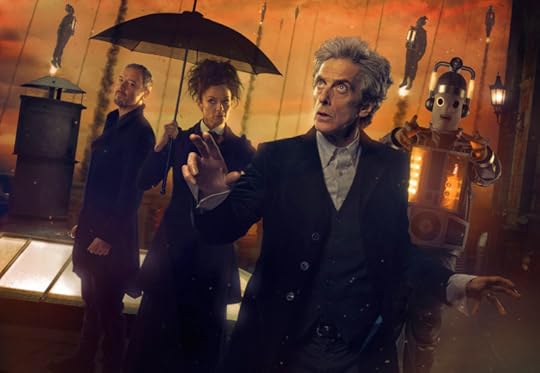
WARNING: Embargoed for publication until 00:00:01 on 25/06/2017 – Programme Name: Doctor Who S10 – TX: 01/07/2017 – Episode: n/a (No. 12) – Picture Shows: ***EMBARGOED UNTIL 00:01hrs SUNDAY 25th JUNE 2017*** The Master (JOHN SIMM), Missy (MICHELLE GOMEZ), The Doctor (PETER CAPALDI) – (C) BBC/BBC Worldwide – Photographer: Simon Ridgway/Ray Burmiston
World Enough & Time/The Doctor Falls
Of all the epic Capaldi finales, this one was the most epic. No PRESSURE, Twice Upon a Time. The banter between Capaldi and Missy was sparkling, every scene was emotionally perfect, and the whole John Simm reveal, despite being flagged, was… well, I was fooled long enough for it to make me shriek out loud in sync with my eldest child, and what more can you ask? The wrench of Cyberman Bill, the amazing romcom snark of Capaldi and the Two Masters, the creeping horror of the end…. and the magical, COMPLETELY JUSTIFIED Chekhov’s Girlfriend save in the final instance was just perfect. (not to mention sending Bill off to further adventures as she graduates from the TARDIS…) I love every second of this two parter. Doctor Who doesn’t get better than this.
Almost made the list: Oxygen, Last Christmas, The Magician’s Apprentice/The Witch’s Familiar, Listen, Mummy on the Orient Express, Extremis/The Pyramid at the End of the World (but not The Lie of the Land), The Girl Who Died, Time Heist.
December 18, 2017
Let Sleeping Princes Lie – Part 9, Gone To See A Witch About A Spinning Wheel
Get the new episode here!

Previous Episodes of this story:
Part 1, Charming Dreaming
Part 2, The First Rule of Spinning Wheels
Part 3, Royal Coping Mechanisms 101
Part 4, You Spin Me Right Round, Baby
Part 5, Kiss the Quill
Part 6, Somewhere Over the Rainbow
Part 7, Sometimes, Witches
Part 8, Monsters Under the Bed
New book alert! My superhero novella Girl Reporter is available for pre-order on Amazon now. Drops on December 19!
Sign up to my author newsletter for updates, follow me on Twitter at @tansyrr or @sheepmightfly, find me on Facebook at TansyRRBooks, and if you like this podcast consider supporting me at Patreon where you can receive all kinds of cool rewards, early ebooks and exclusive stories for a small monthly pledge.
See you next week!
December 11, 2017
Let Sleeping Princes Lie – Part 8, Monsters Under the Bed
Get the episode here
Previous Episodes of this story:
Part 1, Charming Dreaming
Part 2, The First Rule of Spinning Wheels
Part 3, Royal Coping Mechanisms 101
Part 4, You Spin Me Right Round, Baby
Part 5, Kiss the Quill
Part 6, Somewhere Over the Rainbow
Part 7, Sometimes, Witches
New book alert! My superhero novella Girl Reporter is available for pre-order on Amazon now.
Sign up to my author newsletter for updates, follow me on Twitter at @tansyrr or @sheepmightfly, find me on Facebook at TansyRRBooks, and if you like this podcast consider supporting me at Patreon where you can receive all kinds of cool rewards, early ebooks and exclusive stories for a small monthly pledge.
See you next week!
December 3, 2017
Galactic Suburbia Episode 179 Show Notes
Get the new episode here.
It’s our Holiday Gift Recs Extravaganza! Prepare to do some serious online shopping while you listen to our recs.
WHAT DO WE CARE ABOUT THIS WEEK?
Alex moonlighted on Paleo Cinema Podcast with a Disaster Movie special episode!
We look at a list of the 33 Best SFF books by women (hooray for lists with more than one)
Kate Gordon’s new novel raising funds for White Ribbon Australia against domestic violence – 25 Memories of Viggo McDuff
Holiday gift recs!
For cooks: Salt, Fat, Acid, Heat by Samin Nosrat
Tiptree cookbook: The Bakery Men Don’t See, now available in shiny new edition.
Nerd Girl Yarns
Fiction: The Silver Well, Kate Forsyth and Kim Wilkins; Persepolis Rising, James SA Corey
For children & lovers of great children’s fiction: The Dragon with the Chocolate Heart by Stephanie Burgis
Give a novella: Ellen Klages – Passing Strange, Martha Wells – All Systems Red, The Murderbot Diaries.
Movie money
Book Bath Box & other subscription boxes
Chocolate!
Gin
Coffee 3000 Thieves
Whiskey
stationery
From our listeners:
Ellen recs Ideal Bookshelf on Etsy for adorable book pins such as this version of A Wrinkle in Time.
Elizabeth recs Femmecraft on Etsy (the Fight Like a Girl Squirrel Girl piece we mention specifically is already sold out, wah). Elizabeth also points us at Raven’s Dreaming, the Perth-based artist who did the cover for Juliet Marillier’s collection Prickle Moon.
For young readers and their parents, Mel recommends Rocket Science for Babies by Chris Ferrie, and for the slightly older readers – Ada Twist, Scientist by Andrea Beaty.
Kathryn L pointed us at this Kickstarter.
OUR STUFF:
Luminescent Threads
Tara Sharp
Musketeer Space & Joyeux by Tansy
CULTURE CONSUMED:
Alisa: Girl Reporter, Tansy Rayner Roberts
Alex: The Red Queen; Thor: Ragnarok; On Joanna Russ; Girl Reporter; Lotus Blue, Cat Sparks; The Silver Well, Kate Forsyth and Kim Wilkins
Tansy: Killjoys, Choices: The Crown & the Flame, #ThorryNotThorry, the Avengers Infinity War trailer, Dragonette (Jam by Kate/Just Add Moonshine)
Please send feedback to us at galacticsuburbia@gmail.com, follow us on Twitter at @galacticsuburbs, check out Galactic Suburbia Podcast on Facebook, support us at Patreon – which now includes access to the ever so exclusive GS Slack – and don’t forget to leave a review on iTunes if you love us!

